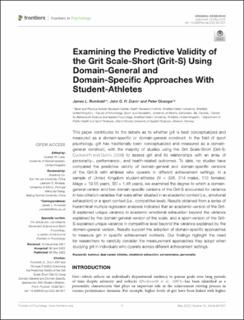| dc.contributor.author | Rumbold, James L. | |
| dc.contributor.author | Dunn, John G. H. | |
| dc.contributor.author | Olusoga, Peter | |
| dc.date.accessioned | 2023-02-15T08:59:09Z | |
| dc.date.available | 2023-02-15T08:59:09Z | |
| dc.date.created | 2022-08-25T11:06:47Z | |
| dc.date.issued | 2022 | |
| dc.identifier.citation | Frontiers in Psychology. 2022, 13 . | en_US |
| dc.identifier.issn | 1664-1078 | |
| dc.identifier.uri | https://hdl.handle.net/11250/3050938 | |
| dc.description.abstract | This paper contributes to the debate as to whether grit is best conceptualized and measured as a domain-specific or domain-general construct. In the field of sport psychology, grit has traditionally been conceptualized and measured as a domain-general construct, with the majority of studies using the Grit Scale-Short (Grit-S: Duckworth and Quinn, 2009) to assess grit and its relationships with an array of personality-, performance-, and health-related outcomes. To date, no studies have compared the predictive validity of domain-general and domain-specific versions of the Grit-S with athletes who operate in different achievement settings. In a sample of United Kingdom student-athletes (N = 326, 214 males, 112 females; Mage = 19.55 years, SD = 1.48 years), we examined the degree to which a domain-general version and two domain-specific versions of the Grit-S accounted for variance in two criterion variables that were either situated in an academic context (i.e., emotional exhaustion) or a sport context (i.e., competitive level). Results obtained from a series of hierarchical multiple regression analyses indicated that an academic-version of the Grit-S explained unique variance in academic emotional exhaustion beyond the variance explained by the domain-general version of the scale, and a sport-version of the Grit-S explained unique variance in competitive level beyond the variance explained by the domain-general version. Results support the adoption of domain-specific approaches to measure grit in specific achievement contexts. Our findings highlight the need for researchers to carefully consider the measurement approaches they adopt when studying grit in individuals who operate across different achievement settings. | |
| dc.language.iso | eng | en_US |
| dc.rights | Navngivelse 4.0 Internasjonal | * |
| dc.rights.uri | http://creativecommons.org/licenses/by/4.0/deed.no | * |
| dc.title | Examining the Predictive Validity of the Grit Scale-Short (Grit-S) Using Domain-General and Domain-Specific Approaches With Student-Athletes | en_US |
| dc.title.alternative | Examining the Predictive Validity of the Grit Scale-Short (Grit-S) Using Domain-General and Domain-Specific Approaches With Student-Athletes | en_US |
| dc.type | Peer reviewed | en_US |
| dc.type | Journal article | en_US |
| dc.description.version | publishedVersion | |
| dc.source.pagenumber | 0 | en_US |
| dc.source.volume | 13 | en_US |
| dc.source.journal | Frontiers in Psychology | en_US |
| dc.identifier.doi | 10.3389/fpsyg.2022.837321 | |
| dc.identifier.cristin | 2045926 | |
| cristin.ispublished | true | |
| cristin.fulltext | original | |
| cristin.qualitycode | 1 | |

